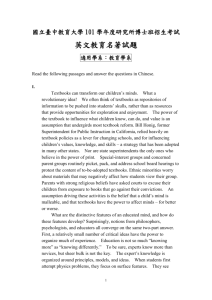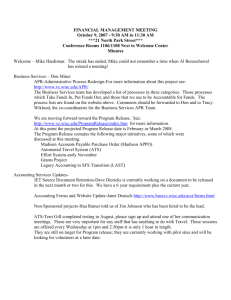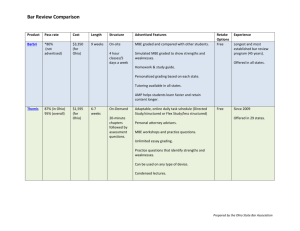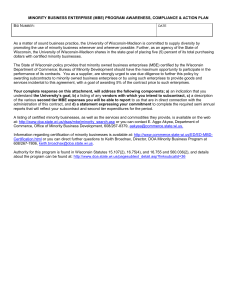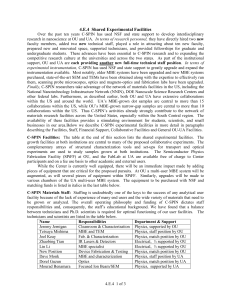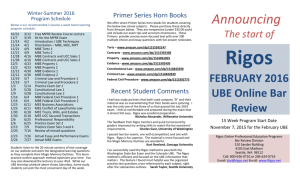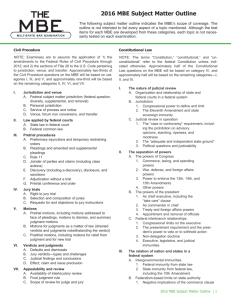MBE are presented
advertisement
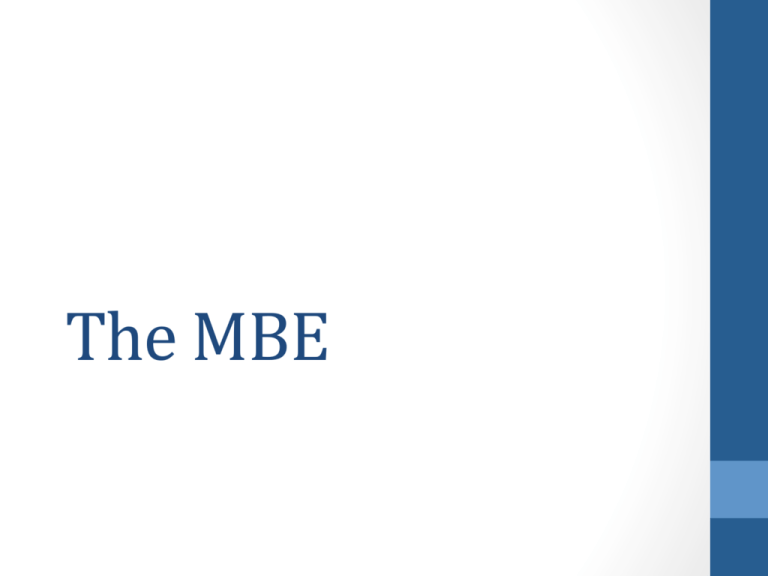
The MBE MBE Overview • Offered on the same day in every jurisdic4on – last Wednesday in July. • 200 mul4ple choice ques4ons, 190 of which are scored. The 10 unscored ques4ons are being evaluated for future use. • The exam is divided into morning and aGernoon tes4ng sessions of three (3) hours each, with 100 ques4ons in each session. • Exam is given na4onwide – You must know the majority approach on any given topic and ignore the local/state law. • The 190 scored ques4ons on the MBE are distributed as follows: • • • • • • • 31 Con Law 33 Contracts 31 Criminal Law/Criminal Procedure 31 Evidence 31 Real Property 33 Torts Civil Procedure (February 2015) A Few Things You Should Know… • You can write in the ques4on booklet – Feel free to take whatever notes help you, highlight whatever you feel needs highligh4ng, and mark correct and incorrect responses in the margins. • Compartmentalize – Do not let your reac4on to any one ques4on influence how you face ensuing ques4ons. • Relax – During the course of your bar review you will do over 2,000 prac4ce ques4ons (roughly 34 a day for the en4rety of your bar review period). Take confidence from your diligent prepara4on. Timing • MBE is a 4med test – 100 ques4ons in 3 hours or, stated another way, you will need to answer a ques4on every 1.8 minutes. • Whatever you do, don’t get behind. It is impera4ve that you s4ck to a schedule when you take the MBE. With a hundred ques4ons to answer in each of the two, three-­‐hour sessions, you should finish 17 ques4ons every half hour. • If possible, do not skip around – You will find you do not have 4me to go back to the ques4ons you skipped. Scoring • The score needed to pass the MBE varies according to where you’re taking the exam, because the Bar Examiners of each jurisdic4on use the MBE in different ways. • All ques4ons on the MBE are given the same weight. • You will receive to scores – A raw score and a scaled scored (scale ranges 10-­‐15 points – The purpose of scaling is to normalize performance across all MBE administra4ons) • As a general rule, if you can 130 “raw” ques4ons correct, you should be on track to pass even in a tough jurisdic4on • Answer every ques4on. You will not lose points for wrong answers. Even if you don’t know the answer, you should guess. A Few Pieces of Advice About Studying for the MBE • Do prac4ce ques4ons religiously – Typically 34 ques4ons per day – over 2,000 over the course of a bar review period. Regular prac4ce will also help you build your endurance. • When you first start doing MBE prac4ce ques4ons, do not 4me yourself. In fact, do not worry about 4me. You will likely find, as many examinees do, that you miss a fair number of the ques4ons and it takes you a while to read and answer each ques4on. • Make sure you take the prac4ce MBE tests your bar review provider offers. It is cri4cally important that you simulate tes4ng prior to the bar exam. There is physical and mental aspect to the MBE for which you must prepare yourself. A Few Pieces of Advice About Studying for the MBE • Track your MBE percentages. When you prac4ce, keep a log of the percentage you’re geeng right. If you can get up 65-­‐70% correct, you are in the passing zone. • Begin by prac4cing one subject at a 4me and reinforcing the substan4ve law. Do mixed-­‐subject MBE sets during the last part of your bar prepara4on. • Read the MBE instruc4ons well in advance of the exam: hhp://www.ncbex.org/assets/media_files/Informa4on-­‐ Booklets/MBEIB2014.pdf Question Format • Mul4ple choice from a given set of facts. Each ques4on has four possible answer op4ons, with one correct answer and three incorrect choices. • Ques4ons on the MBE are presented in a completely random manner. Both the level of difficulty and subject maher may vary from one ques4on to the next. Five Common MBE Question Formats • Winner/reason ques:ons – These ques4ons require you to decide which party should prevail in a lawsuit or prosecu4on and to choose the best explana4on for that result. Thus, an answer to such a ques4on can be incorrect because it either names the wrong prevailing party or gives the wrong reason: Able and Behy entered into nego4a4ons for a contract by which Able, an expert tour guide, would serve as Behy’s tour guide for a one-­‐week tour of New York City. Behy said, “I will pay you $1,500 to serve as my tour guide.” Able replied, “Would you be willing to consider paying me $2,000?” “No,” said Behy. “Then I’ll take the $1,500,” said Able. Two weeks later, Behy informed Able that she had hired Carl to work as her tour guide. In ac4on by Able against Behy for breach of contract Able will: A. Win, because he accepted Behy’s offer. B. Win, based on the doctrine of promissory estoppel. C. Lose, because he made a counteroffer and therefore terminated his power to accept Behy’s offer. D. Lose, because he did not rely on the contract in any way. Five Common MBE Question Formats • Result/reason ques:ons: These ques4ons, which are similar to winner/reason ques4ons, require examinees to predict a result on a somewhat narrower issue (for example, evidence is admissible or inadmissible, the mo4on will succeed or not succeed, etc.) and the best explana4on for that result. Thus, an answer can be incorrect because it either incorrectly predicts the result or gives the wrong reason. Danielle and Paul entered into a valid and enforceable wrihen contract for the purchase by Paul and sale by Danielle of Greenacre for $100,000. The contract was very detailed, thirty pages long, and included a merger clause. Assume the contract was made and the par4es reside in a jurisdic4on that has adopted Williston’s approach to parol evidence rule ques4ons. If Paul seeks to tes4fy that aGer the par4es signed the agreement, Danielle promised to arrange for the hardwood floors in the house to be refinished, the evidence will be: A. Barred, because the agreement is completely integrated. B. Barred, because it is inconsistent with the par4es’ wrihen agreement. C. Admihed, because the parol evidence rule doesn’t apply to such evidence. D. Admihed, because the agreement is not completely integrated and the wri4ng is silent about refinishing the floors. Five Common MBE Question Formats • Best argument or theory ques:ons. These ques4ons, which are less common than the first two formats, end with an incomplete sentence such as “Myra’s best argument for _____ is,” and then the answers give alterna4ve arguments or theories that Myra might use. Thus, an answer to such a ques4on may be incorrect either because it’s wrong or because it’s not the best argument. Sally, who is a manufacturer of big screen televisions, and Bob entered into a valid and enforceable wrihen contact for the purchase by Bob from Sally of a “Sally Biggy,” a seventy-­‐five inch big screen television set for $4,500. Sally an4cipated making $1,500 in profit on the sale. Bob breached the contract, and Sally sold the Sally Biggy that Bob had agreed to purchase for $4,5000. in ac4on seeking her lost profits, Sally’s best argument would be: A. Sally is a lost-­‐volume seller. B. Sally’s lost profit is a legi4mate item of consequen4al damages. C. Sally’s lost profit compensates her for her 4me and money spent readver4sing and reselling the television. D. Sally should be awarded the money under the doctrine of in pari delicto. Five Common MBE Question Formats • Mul:ple answer ques:ons. This format which is much less common than the first three formats, ends with two or three statements. The ques4on asks the examinee to determine which of the two or three statements are correct, and the answers describe a variety of combina4ons of the statements (for example, the first and the second, the first and the third, the second and the third, etc.). Thus, an answer to this ques4on is correct only if it describes precisely which statements are accurate. Carl, who had never worked before as a grocery store clerk, and Store entered into an oral agreement whereby Carl agreed to work full-­‐4me for Store as a grocery clerk for six months, and Store agreed to pay Carl $3,000 per month. One week later, Carl announced that he refused ever to work for Store. If Store sued Carl seeking specific performance as its only remedy and the court denied Store’s request, which of the following grounds would jus4fy this result? I. The statute of frauds because the contracts exceeds $5,000 and is not I wri4ng II. A grant of specific performance would violate the Cons4tu4on III. Store’s remedy at law is not adequate A. I and II only B. I and III only C. II and III only D. I, I and III Five Common MBE Question Formats • Same fact paCern, mul:ple ques:ons. This format is also less common than the first three formats. These ques4ons provide a fact pahern followed by two or more ques4ons that all rely on the same fact pahern. In many cases, the ques4ons add facts for the examinees to consider. The ques4ons themselves are similar to the first three types of ques4ons previously described. Accordingly, the characters of correct and incorrect answers are also similar. Example on next slide… Five Common MBE Question Formats Paula, a famous painter known for her abstract pain4ng style, entered into a valid, wrihen contract draGed by Fred to paint a series of portraits of Fred and his family according to the following schedule: Pain4ng of Fred: Due July 1 for $25,000 Pain4ng of Fred’s wife: Due August 1 for $25,000 Pain4ng of Fred’s house: Due September 1 for $25,000 Pain4ng of Fred’s car: Due October 1 for $20,000 The contract also included the following clause, “Fred’s duty to pay Paula is expressly condi4oned on Fred’s sa4sfac4on with Paula’s work.” At all relevant 4mes, Fred was aware that all of Paula’s past pain4ngs were abstract. Assume that Paula completed the pain4ng of Fred on 4me, but Fred refused to pay for it, claiming that, while he was comfortable with abstract pain4ngs of everyone else, he would only be sa4sfied with a realis4c portrait of himself. In an ac4on by Paula against Fred for breach of contract, Paul will: A. Win, because she substan4ally performed her promise to paint Fred’s portrait B. Win, because Fred’s claim of dissa4sfac4on lacks good faith. C. Lose, because Paula did not substan4ally perform her promise. D. Lose, because of Fred’s duty to pay was expressly condi4oned Five Common MBE Question Formats Previous slide con4nued… Assume all of the facts stated in Ques4on 1. Also assume, for the purposes of this ques-on only, that Fred’s refusal to pay Paula was jus4fied and therefore that Fred did not have to pay Paula for her portrait for Fred. If Fred thereaGer repudiates the en4re contract, Paula’s best argument for enforcing the contract would be: A. She painted Fred’s portrait in good faith. B. Fred is estopped from repudia4ng the contract because he acknowledged that abstract pain4ngs of everyone else would be sa4sfactory to him C. Contra proferentem D. The contract is divisible How Answer Choices Can Be Wrong • Mischaracterizes the facts If the reasoning doesn’t reflect either the facts as they appear in the ques4on or reasonable inferences drawn from those facts, the answer choice cannot be correct Many varia4ons on this theme – Goes beyond the facts, assumes a fact in dispute or even blatantly contradicts the facts • The reasoning is legally wrong Many varia4ons on this – Overstates the requirements of a rule, reasoning uses an4quated rules or rules from inapplicable bodies of law, reasoning applies rules that do not apply to the facts, overinclusive statements of the law, overstate or understate the applicable legal standard • Not as precise as another choice Issue Spotting on the MBE • On the MBE you have to be able to do the following two things: • Iden4fy the central issue in the problem • Iden4fy what issue each answer is addressing • Determining the central issue – What, in theory, is going on with this problem? • Your best answer will resolve the central issue in the problem How to Analyze MBE Questions • First, read the call of the ques4on and the answer choices first – This will help you determine the area of law and focus your reading of the fact pahern. Remember, you will have to spot both the subject and the issue. • Then read the facts. • AGer reading the facts, determine the central issue in the problem • Recall immediately the rule (or rules) relevant to the central issue • Determine which issue each answer is addressing and then select the best, most precise answer (the answer that correctly characterizes the law and the facts and addresses the central issue) How to Analyze MBE Questions On the MBE, you will likely want to reword the call of the ques4on. This will force you to focus on the one correct answer. Most MBE ques4on calls are wrihen in a way that can feel confusing. For example: Ques4on: What is the most likely outcome? Reword to: What will the result be – and why? Ques4on: Which claim is most likely to succeed? Reword to: Which is the only claim that can succeed on these facts – and why? Ques4on: What is Defendant’s best defense? Reword to: Why won’t the Defendant be guilty on these facts? Ques4on: “If party X loses, the most likely basis for the judgment is that…” Reword to: “Party X loses because…” Ques4on: “Which of the following would be the LEAST sufficient basis for admieng the recording?” Reword to: “Why won’t the recording be admissible?” How to Analyze MBE Questions • Don’t assume facts – Be careful not to read into ques4ons facts that are not there. The MBE is a me4culously craGed test. The facts you need to answer the ques4on will be given to you. However, you may make reasonable inferences based on the facts provided. • Choose the simple interpreta4on – Don’t make problems more complex than they really are. If there are mul4ple ways to interpret a ques4on, one that makes the problem straightorward and other that make it very difficult, choose the straightorward interpreta4on. • You should arrive at the correct answer by elimina4ng, one by one, any answer that clearly cannot be correct. • Make your answer selec4on and s4ck with it. Do not go back and change your answer unless you’re certain your first choice was wrong. How to Analyze MBE Questions • Pay ahen4on to statutes – Generally given for one of two reasons: Conflic4ng common law rules, therefore no one majority rule or the Examiners want to see if you can ignore your ins4ncts • Pay special ahen4on to seemingly meaningless details about people. While the examiners do some4mes give you a deliberate red herring, you should always assume that every fact in every ques4on is important. • Pay ahen4on to the language modifiers in the answer choices ModiIiers • Many MBE answers will have three dis4nct parts: the result, the reasoning to support that result and the modifier. As a general rule, you want to read the reasoning and modifier before the result because the modifier can change the result. • Because is the modifier – “Yes, because the the farmer did not have a privilege to use excessive force.” • Because is by far the most common modifier on the MBE. “Since” and “as” should be treated the same as “because.” If “because” is the modifier, the answer can be correct only if: • The reasoning addresses and resolves a central issue (or at least a more central issue than any other response) • The facts in the ques4on completely sa4sfy the reasoning AND • The result is consistent with the reasoning ModiIiers • When “if” is the modifier, in order to be correct, the reasoning need only be plausible under facts (that is there can’t be anything in the facts to suggest the reasoning couldn’t be true) Example: “Yes, if the husband reasonably believed that the dog might bite him.” • Big difference between “because” and “If” is that “because” reasoning must flow unequivocally from the facts; the “if” reasoning must only be plausible If “If” is the modifier: • The reasoning addresses and resolves a central issue • The reasoning need only be plausible under the facts How to Guess Intelligently Apply the following advice only when your reasoning fails you. • Don’t guess un4l you’ve eliminated all the definitely wrong responses • Factors that should influence your guess: • Beware of terms that seem like they should apply to a wide variety of facts, but that actually have no applica4on to the par4cular fact situa4on • Beware of certain4es Question 1 Before pueng her home up for sale, a homeowner painted the living room ceiling to conceal major water damage caused by a leaking roof that had not been repaired. On the first day the home was offered for sale, the homeowner gave a buyer a personal tour. The homeowner made no statements at all regarding the water damage or the roof. Without discovering the water damage or the leaking roof and without consul4ng a lawyer, the buyer immediately agreed in wri4ng to buy the home for $200,000. Before the closing date, the buyer discovered the water damage and the leaking roof. The cost of repair was es4mated at $22,000. The buyer has refused to go through with the purchase. If the homeowner sues the buyer for breach of contract, is the homeowner likely to prevail? A. No, because no contract was formed since the buyer did not have a real opportunity to understand the essen4al terms of the contract. B. No, because the homeowner concealed evidence of the water damage and of the leaking room. C. Yes, because the homeowner made no affirma4ve statements of fact about the water damage or the leaking roof. D. Yes, because the buyer acted unreasonably by failing to employ an inspector to conduct an independent inspec4on of the home. Relevant Law • Contracts • Correct answer is B • “If one party’s assent to a contract is induced by a material misrepresenta4on by the other, on which the recipient is jus4fied in relying, the contract is voidable by the recipient • Normally a party’s silent failure to men4on a fact will not cons4tute a misrepresenta4on as to that fact. But inten4onal acts of concealment are deemed to be equivalent to misrepresenta4ons. Question 2 A man and his friend were watching a televised football game at the man’s home. Upset by a penalty called by the referee, the friend threw a bohle of beer at the man’s television, breaking the screen. Enraged, the man picked up a nearby hammer and hit the friend on the head with it. The friend died from the blow. The crimes below are listed in descending order of seriousness. In a jurisdic4on that follows common law principles, what is the most serious crime of which the man could be properly convicted? A. Murder B. Voluntary manslaughter C. Involuntary manslaughter D. Assault Relevant Law • Criminal Law • Correct answer is A • At common law, one of the mental states that suffices for murder is intent to do bodily harm. The intent to do serious bodily injury can be inferred from the defendant’s conduct in light of the surrounding circumstances. The defendant’s choice of weapon, and the nature of the physical ahack on the vic4m, are circumstances that can lead a reasonable jury to infer an intent to seriously injure the vic4m. Since the friend’s death directly resulted from the man’s conduct all the requirements for murder of the intent to do serious bodily injury variety are present. • A jury might accept the par4al defense of reasonable provoca4on , which would downgrade the crime to voluntary manslaughter. But a reasonable jury could certainly reject the provoca4on defense, in which case a murder convic4on would be appropriate and you’re asked to specify the most serious crime of which the defendant “could properly be convicted.” Question 3 A landlord and tenant orally agreed to a commercial tenancy for a term of six months beginning on July 1. Rent was to be paid by the first day of each month, and the tenant paid the first month’s rent at the 4me of the agreement. When the tenant arrived at the leased premises on July 1, the tenant learned that the previous tenant had not vacated the premises at the end of her lease term on May 31 and did not intend to vacate. The tenant then successfully sued the previous tenant for possession. The tenant did not inform the landlord of the evic4on ac4on un4l aGer the tenant received possession. The tenant then sued the landlord claiming damages for that por4on of the lease period during which the tenant was in possession. If the court finds for the landlord, what will be the most likely explana4on? A. By suing the previous tenant for possession, the tenant elected that remedy in lieu of a suit against the landlord B. The landlord had delivered the legal right of possession to the tenant C. The tenant failed to 4mely vacate as required to sue for construc4ve evic4on D. The tenant had not no4fied the landlord before bringing the evic4on ac4on Relevant Law • Property • Correct answer – B • We can infer from the landlord’s victory that we are in a jurisdic4on that does not require the landlord to put the tenant into actual possession. • It’s clear the landlord has given the new tenant the legal right to possess the premises, and that the landlord hasn’t given a conflic4ng legal right to anyone else (the holdover tenant’s term is over, so that tenant cannot be asser4ng that he has a legal right to possession deriving from the landlord. Furthermore, there’s no indica4on that the landlord or any third person claiming under him has asserted a legal claim to possession of the premises. • The tenant can win if, and only if, the landlord is found to have had an implied duty to deliver actual possession to the tenant. American courts are split – Most courts follow the “English” rule under which the landlord has an implied duty to deliver actual possession. But a minority follow the so-­‐called “American” rule, under which the landlord is merely required to give the tenant legal possession. Question 4 A homeowner was using a six-­‐foot stepladder to clean the furnace in his home. The homeowner broke his arm when he slipped and fell from the ladder. The furnace had no warnings or instruc4ons on how it was to be cleaned. In a suit by the homeowner against the manufacturer of the furnace to recover for his injury, is the homeowner likely to prevail? A. No, because the danger of falling from a ladder is obvious B. No, because the homeowner should have hired a professional to clean the furnace C. Yes, because the furnace did not have a ladder ahached to it for cleaning purposes D. Yes, because the lack of warnings or instruc4ons for how to clean the furnace made it defec4ve Relevant Law • Torts • Correct Answer is A • In a suit based on strict product liability (as the suit would likely be here), the manufacturer’s failure to warn of a danger can itself make the product defec4ve, and trigger strict liability for injuries caused by that defect. But the seller or manufacturer of a product is generally not liable for failing to warn against a danger that is obvious and foreseeable to users of that product. • Here the ordinary dangers of working on a ladder are obvious. And there appears to be nothing about using a ladder to clean this furnace that increases the danger of ladder use generally. So the manufacturer’s failure to warn bout the dangers of ladder use did not make the furnace defec4ve. And nothing else in these facts supplies any other ground for imposing either strict liability or liability for negligence. Question 5 A cyclist sued a defendant corpora4on for injuries sustained when she was hit by a truck owned by the defendant and driven by its employee, who was making deliveries for the defendant. The day aGer the accident, the employee visited the cyclist in the hospital and said, “I’m sorry for what I did.” At trial, the employee tes4fied that he had exercised due care. Why is the cyclist’s tes4mony rela4ng what the defendant’s employee said at the hospital admissible to prove negligence? A. It is a prior inconsistent statement B. It is a statement against interest C. It is a statement by a party-­‐opponent’s agent D. It is a statement of then-­‐exis4ng state of mind Relevant Law • Evidence • Correct answer is C • The employee was speaking about a maher that was within the scope of his employment. If the employee’s statement is used to prove that he (and by extension the corpora4on he worked for) was negligent, the proposed use is a hearsay use. Consequently, must fall within some excep4on or exclusion, or else be inadmissible. • Applicable rule – Excludes as non-­‐hearsay any statement that is offered against an “opposing party and that was made by the party’s agent or employee on a maher within the scope of that rela4onship and while it existed.” • Here, we’re told that the driver was an employee of the defendant corpora4on, and that he was working for the defendant at the 4me the accident occurred. So that statement about what happened concerned a maher within the speaker’s employment rela4onship with the defendant, and was made while the employment rela4onship s4ll existed. Question 6 A state law provides that a person who has been divorced may not marry again unless he or she is current on all child-­‐support payments. A woman who was refused a marriage license pursuant to this law, sued the appropriate state officials. What standard should the court apply in reviewing the cons4tu4onality of this law? A. The state must show that the law is necessary to serve a compelling government interest B. The state must show that the law is substan4ally related to an important government interest C. The woman must show that the law serves no important public purpose D. The woman must show that the legislature did not have a ra4onal basis for enac4ng the law Relevant Law • Cons4tu4onal Law • Correct answer is A • Correctly states the test for strict scru4ny, which the statute will have to survive. • The woman’s suit would be brought on a substan4ve due process theory. SCOTUS held that marriage is a fundamental right for substan4ve due process purposes (Zablocki v. Redhail). In that case, the Court concluded a similar statute interfered with this fundamental right of marriage, triggering strict scru4ny of the statute. When a state statute is strictly scru4nized, the defender of the statute (here the state) bears the burden of proving that the law is necessary to serve a compelling state interest. Links • MBE Informa4on Booklet hhp://www.ncbex.org/assets/media_files/Informa4on-­‐ Booklets/MBEIB2014.pdf • Good resources available in the law school’s library. Future Bar-­‐Related Programming • Financial Planning for the Bar Exam – 2/5 – Noon • Bar Exam Week – 2/10 – 2/14 • • • • • • • • • • • Character and Fitness Overview – 2/10 – Noon MBE Strategies – 2/11 -­‐ Noon MPT/UBE – 2/12 – Noon Developing a Plan for the Bar Exam/Advice from Recent Takers – 2/13 – Noon MBE Session #1 – Criminal Law/Procedure – Bruck – 2/19 Noon MBE Session #2 – Property – Fraley – 2/27 – Noon MBE Session #3 – Contracts – Calhoun – 3/19 – 3:00 pm Essay Wri4ng for the Bar Exam – 3/25 – 6:00 pm MBE Session #4 – Torts – Murchison – 3/26 – Noon MBE Session #5 – Con Law – Massie – 4/2 – Noon MBE Session #6 – Evidence – Belmont – 4/9 -­‐ Noon
